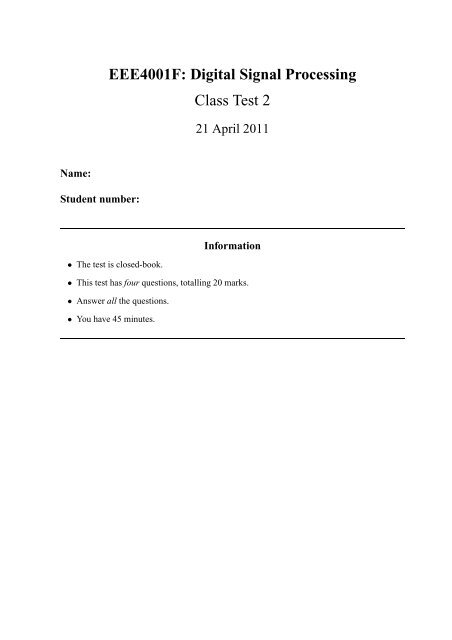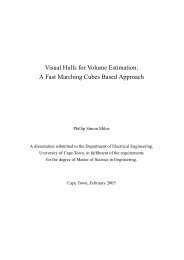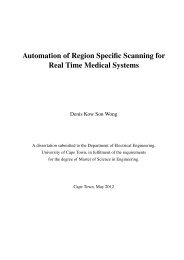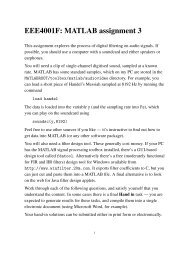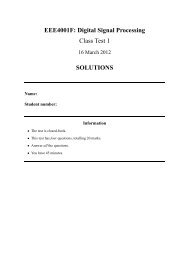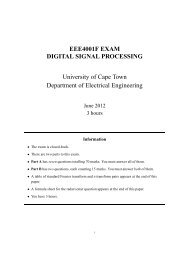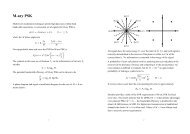Test - UCT Digital Image Processing
Test - UCT Digital Image Processing
Test - UCT Digital Image Processing
Create successful ePaper yourself
Turn your PDF publications into a flip-book with our unique Google optimized e-Paper software.
EEE4001F: <strong>Digital</strong> Signal <strong>Processing</strong><br />
Class <strong>Test</strong> 2<br />
21 April 2011<br />
Name:<br />
Student number:<br />
Information<br />
• The test is closed-book.<br />
• This test has four questions, totalling 20 marks.<br />
• Answer all the questions.<br />
• You have 45 minutes.
1. (5 marks) Determine the 8-point DFT of the real-valued sequencex[n] = δ[n−3]. Plot<br />
the magnitude and phase of your answer on separate axes, ensuring that the phase lies<br />
between −π and π.
2. (5 marks) Consider the system below<br />
x(t)<br />
C/D<br />
x[n]<br />
H(e jω )<br />
y[n]<br />
T<br />
where T = 0.001s and<br />
⎧<br />
⎨<br />
H(e jω 1 |ω| ≤ 0.5π<br />
) =<br />
⎩0 otherwise<br />
for−π ≤ ω ≤ π. Find the outputy[n] if the input isx(t) = cos(400πt)+cos(600πt).
3. (5 marks) Findw[n] = x[n]∗y[n] with<br />
x[n] = e jπn/3 and<br />
y[n] = sin(π(n−5)/2) .<br />
π(n−5)
4. (5 marks) Two students want to analyse a signal from a microphone. They digitise a<br />
sample of 128 points, obtaining the signal below:<br />
2<br />
x[n]<br />
0<br />
-2<br />
0 20 40 60 80 100 120<br />
They decide to investigate the apparent periodicity by looking at the signal in the<br />
frequency domain. To do this they calculate the DFT<br />
∑127<br />
X[k] =<br />
n=0<br />
n<br />
2π<br />
−j<br />
x[n]e 128 kn<br />
fork = 0,...,127, which has the following magnitude plot:<br />
50<br />
|X[k]|<br />
0<br />
0 20 40 60 80 100 120<br />
(a) What is the dominant frequency present in the signal, measured in radians per sample?<br />
(b) The quantity|X[k]| as calculated is a poor estimate of the spectrum of the microphone<br />
signal. Why is this so? What can be done to improve the estimate?<br />
k
Fourier transform properties<br />
Sequencesx[n],y[n] Transforms X(e jω ), Y(e jω ) Property<br />
ax[n] + by[n] aX(e jω ) + bY(e jω ) Linearity<br />
x[n − n d ] e −jωn dX(e jω ) Time shift<br />
e jω 0 n x[n] X(e j(ω−ω 0 ) ) Frequency shift<br />
x[−n] X(e −jω ) Time reversal<br />
nx[n] j dX(ejω )<br />
dω<br />
Frequency diff.<br />
x[n] ∗ y[n] X(e −jω )Y(e −jω ) Convolution<br />
x[n]y[n]<br />
1<br />
2π<br />
R π<br />
−π X(ejθ )Y (e j(ω−θ) )dθ<br />
Modulation<br />
Common Fourier transform pairs<br />
Sequence<br />
Fourier transform<br />
δ[n] 1<br />
δ[n − n 0 ] e −jωn 0<br />
P<br />
1 (−∞ < n < ∞)<br />
∞<br />
k=−∞<br />
2πδ(ω + 2πk)<br />
a n 1<br />
u[n] (|a| < 1)<br />
1−ae −jω<br />
1<br />
u[n]<br />
1−e −jω + P ∞<br />
k=−∞<br />
πδ(ω + 2πk)<br />
(n + 1)a n 1<br />
u[n] (|a| < 1)<br />
((1−ae −jω ) 2<br />
sin(ωcn)<br />
1 |ω| <<br />
πn<br />
X(e jω ωc<br />
) =<br />
0 ω c < |ω| ≤ π<br />
(<br />
1 0 ≤ n ≤ M<br />
x[n] =<br />
0 otherwise<br />
e jω 0 n<br />
sin[ω(M+1)/2]<br />
e −jωM/2<br />
sin(ω/2)<br />
P ∞<br />
k=−∞ 2πδ(ω − ω 0 + 2πk)<br />
Common z-transform pairs<br />
(<br />
a<br />
n<br />
Sequence Transform ROC<br />
δ[n] 1 All z<br />
1<br />
u[n]<br />
1−z −1 |z| > 1<br />
1<br />
−u[−n − 1]<br />
1−z −1 |z| < 1<br />
δ[n − m] z −m All z except 0 or ∞<br />
a n 1<br />
u[n]<br />
1−az −1<br />
−a n 1<br />
u[−n − 1]<br />
na n u[n]<br />
−na n u[−n − 1]<br />
0 ≤ n ≤ N − 1,<br />
0 otherwise<br />
cos(ω 0 n)u[n]<br />
r n cos(ω 0 n)u[n]<br />
1−az −1<br />
az −1<br />
(1−az −1 ) 2<br />
az −1<br />
(1−az −1 ) 2<br />
|z| > |a|<br />
|z| < |a|<br />
|z| > |a|<br />
|z| < |a|<br />
1−a N z −N<br />
1−az −1 |z| > 0<br />
1−cos(ω 0 )z −1<br />
1−2cos(ω 0 )z −1 +z −2 |z| > 1<br />
1−r cos(ω 0 )z −1<br />
1−2r cos(ω 0 )z −1 +r 2 z −2<br />
|z| > r


